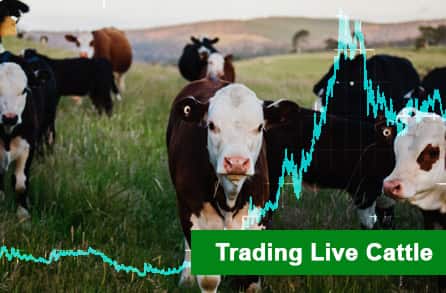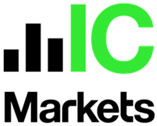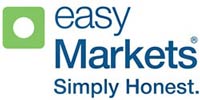Trading Live Cattle Commodities for 2025
We found 11 online brokers that are appropriate for Trading Trading Live Cattle.
Live Cattle commodity broker Guide
Analysis by Andrew Blumer, Updated Last updated – July 08, 2025
Trading Live Cattle

The live cattle trade is a cornerstone of the global agricultural industry, contributing billions of dollars to the economy and providing millions of jobs worldwide. This comprehensive overview delves into the various aspects of the trade, from the diverse range of cattle breeds and innovative farming practices to the ethical considerations and environmental impacts.
Trading Live Cattle Commodities Example

Let’s imagine you’re interested in trading Live Cattle, and the current market price is 187.225 USD per unit. You’ve got 10,000 USD to invest, and you decide to enter a trade.
How the Trade Works
With 10,000 USD, you’ll be able to buy a certain number of contracts of Live Cattle. Let’s assume you’re using leverage, which allows you to control a larger position than the cash you have. If you’re trading with 1:10 leverage, this means you can control a position of 100,000 USD worth of Live Cattle with your 10,000 USD investment.
Based on the current price of 187.225 USD per unit, you could theoretically buy around 534 units of Live Cattle. (This is just an example, and the actual number of units may vary depending on the broker’s margin requirements).
What Happens If the Trade Goes in Your Favor?
Let’s say you predict that the price of Live Cattle will rise, and it does! The price increases from 187.225 USD to 200 USD per unit. This is a gain of 12.775 USD per unit.
With 534 units, your total gain would be:
534 units * 12.775 USD = 6,820.35 USD
This means that if the trade goes in your favor, you’ve made a profit of 6,820.35 USD on your original 10,000 USD investment.
What Happens If the Trade Goes Against You?
Now, let’s consider the opposite scenario. The price of Live Cattle drops instead of rising. Let’s say it falls from 187.225 USD to 175 USD per unit, a loss of 12.225 USD per unit.
In this case, your loss would be:
534 units * 12.225 USD = 6,526.65 USD
This means you would lose 6,526.65 USD from your initial 10,000 USD investment. If the price continues to drop, your losses could increase further. With leveraged trading, losses can exceed your initial investment if the market moves significantly against you.
The Risks of Trading Live Cattle
Trading any commodity, including Live Cattle, carries risks. The biggest risk comes from the volatility of the market. Prices can move quickly, and leverage amplifies both potential profits and losses. If the market moves against you, you could face a margin call, meaning your broker will require you to add more funds to your account to maintain the position.
Always use risk management tools like stop-loss orders, which can help limit your losses if the market moves in the wrong direction.
In this example, trading Live Cattle can be profitable if the market moves in your favor, but it’s also risky if the price drops. Always trade with caution, use leverage wisely, and never invest more than you’re willing to lose.
Global Overview of Trading Live Cattle

The cattle trade is a vital component of the agricultural sector worldwide. Dominant cattle breeds raised globally include Boran, Zebu, and Friesian, among others. The global cattle trade faces several challenges, such as drought, diseases, and limited access to markets, which can impact production and pricing. However, there are also significant opportunities for growth, including increasing demand for beef in both domestic and international markets.
To engage in cattle trading globally, it is important to understand local regulations and market dynamics. For more details on U.S. cattle trading regulations, visit the USDA Animal and Plant Health Inspection Service.
Cattle Types and Farming Practices
There are two primary types of cattle raised for commercial purposes: feeder cattle and dairy cows. Feeder cattle are primarily raised for meat production. They are typically fed a diet of grain and other high-energy feed to reach a target weight of around 1,200 to 1,400 pounds before being slaughtered. Dairy cows, on the other hand, are bred for their milk production and are typically kept in confinement and milked regularly.
Cattle Breeds
The choice of cattle breed can significantly impact factors such as growth rate, meat quality, and milk production. Some popular beef cattle breeds include:
- Angus: Known for their high-quality beef with excellent marbling.
- Hereford: Hardy and adaptable, with a distinctive red and white coat.
- Limousin: A French breed known for its fast growth rate and lean meat.
- Charolais: A French breed known for its large size and high-quality beef.
Dairy cattle breeds, such as Holstein Friesian and Jersey, are selected for their milk production capabilities.
Modern Cattle Farming Technologies
Technological advancements have significantly transformed the cattle farming industry. Artificial insemination allows for the controlled breeding of cattle, enabling farmers to select for desired traits. Automated feeding systems ensure consistent and efficient delivery of feed to cattle, improving productivity and reducing labor costs. Additionally, precision livestock farming technologies, such as sensors and data analytics, are used to monitor cattle health, behavior, and environmental conditions.
Cattle Products and By-Products That Can Be Traded
Beef is the primary product derived from cattle. However, cattle also produce numerous by-products, including:
- Leather: Used in a variety of products, such as shoes, clothing, and furniture.
- Hides: Used for leather production and other industrial applications.
- Bones: Used for animal feed, gelatin, and other products.
- Organs: Used for medical research and pharmaceutical products.
How to Trade Cattle
Trading cattle involves several practical steps:
- Research the Market: Understand current market trends, prices, and demand for live cattle. For insights, refer to the USDA Economic Research Service.
- Choose a Trading Method: You can trade cattle directly through local auctions, sell to feedlots, or use online platforms like Rancher.com and Agriculture.com.
- Network with Buyers: Build relationships with buyers, including meatpackers and feedlots. Attend livestock shows and industry events, such as the National Western Stock Show.
- Evaluate Your Cattle: Assess the health, weight, and breed quality of your cattle. Tools like Angus Genetics help evaluate breed-specific characteristics.
- Negotiate Sales: Use live bidding platforms to understand market dynamics and negotiate favorable prices.
- Handle Logistics: Ensure proper transportation and comply with health inspections and transport permits. Learn more from the USDA APHIS.
Live Cattle Prices
Compared to pork or poultry, beef can be more expensive. Price elasticity is influenced by demand for animal protein, which varies with changing consumer preferences for grass-fed or organic options and economic conditions. In May 2020, the USDA projected reduced demand and supply, estimating beef production to fall to 26 billion pounds (source: USDA), a decrease of around 1.68 billion pounds from April. More recent data from 2023 indicates recovery in production levels, reaching approximately 28 billion pounds.
Speculative purchases may decline due to soaring wholesale prices for U.S. beef and pork, and meatpacking plants continue to face labor shortages due to the pandemic. While demand in the U.S. is increasing, beef prices are rising, and boxed beef demand is up. Global factors, including trade relations and export opportunities, will shape the future of the cattle industry.
Ethical Considerations and Sustainability in Live Cattle Trading
The live cattle trade faces increasing scrutiny regarding ethical and environmental concerns. Animal welfare standards, including adequate housing, nutrition, and care, are paramount. Ethical sourcing initiatives promote responsible practices throughout the supply chain, from farm to fork.
Sustainability is another critical aspect. Efforts to reduce the environmental impact of cattle farming include sustainable grazing practices, methane reduction technologies, and regenerative agriculture. These initiatives aim to protect natural resources, mitigate climate change, and ensure the long-term viability of the industry.
Factors Influencing Cattle Prices
Several factors can influence the price of live cattle, including:
Supply and demand: The balance between the supply of cattle and consumer demand for beef drives prices.
Feed costs: The price of feed, primarily corn and soybeans, can significantly impact the cost of raising cattle.
Economic conditions: Overall economic factors, such as consumer income and disposable income, can influence beef consumption and, consequently, cattle prices.
Government policies: Government policies related to agriculture, trade, and environmental regulations can affect the cattle market.
Trading Live Cattle Verdict

The live cattle trade is a multifaceted industry with significant economic, ethical, and environmental implications. By understanding the diverse range of cattle breeds, innovative farming practices, ethical considerations, and sustainability challenges, we can appreciate the industry's complexity and its potential to contribute to a sustainable and resilient food system.
We have conducted extensive research and analysis on over multiple data points on Trading Live Cattle Commodities to present you with a comprehensive guide that can help you find the most suitable Trading Live Cattle Commodities. Below we shortlist what we think are the best trading live cattle after careful consideration and evaluation. We hope this list will assist you in making an informed decision when researching Trading Live Cattle Commodities.
Reputable Live Cattle commodity broker Checklist
Selecting a reliable and reputable online Trading Live Cattle trading brokerage involves assessing their track record, regulatory status, customer support, processing times, international presence, and language capabilities. Considering these factors, you can make an informed decision and trade Trading Live Cattle more confidently.
Selecting the right online Trading Live Cattle trading brokerage requires careful consideration of several critical factors. Here are some essential points to keep in mind:
- Ensure your chosen Trading Live Cattle broker has a solid track record of at least two years in the industry.
- Verify that the Trading Live Cattle broker has a customer support team of at least 15 members responsive to queries and concerns.
- Check if the Trading Live Cattle broker operates under the regulatory framework of a jurisdiction that can hold it accountable for any misconduct or resolve disputes fairly and impartially.
- Ensure that the Trading Live Cattle broker can process deposits and withdrawals within two to three days, which is crucial when you need to access your funds quickly.
- Look for Trading Live Cattle brokers with an international presence in multiple countries, offering its clients local seminars and training programs.
- Ensure the Trading Live Cattle broker can hire staff from diverse locations worldwide who can communicate fluently in your local language.
Our team have listed brokers that match your criteria for you below. All brokerage data has been summarised into a comparison table. Scroll down.
Compare Key Features of Trading Live Cattle in Our Brokerage Comparison Table
When choosing a broker for trading live cattle trading, it's essential to compare the different options available to you. Our trading live cattle brokerage comparison table below allows you to compare several important features side by side, making it easier to make an informed choice.
- Minimum deposit requirement for opening an account with each trading live cattle broker.
- The funding methods available for trading live cattle with each broker.
- The types of instruments you can trade with each trading live cattle broker, such as forex, stocks, commodities, and indices.
- The trading platforms each trading live cattle broker provides, including their features, ease of use, and compatibility with your devices.
- The spread type (if applicable) for each trading live cattle broker affects the cost of trading.
- The level of customer support each trading live cattle broker offers, including their availability, responsiveness, and quality of service.
- Whether each trading live cattle broker offers Micro, Standard, VIP, or Islamic accounts to suit your trading style and preferences.
By comparing these essential features, you can choose a trading live cattle broker that best suits your needs and preferences for trading live cattle. Our trading live cattle broker comparison table simplifies the process, allowing you to make a more informed decision.
Top 15 Trading Live Cattle of 2025 compared
Here are the top Trading Live Cattle.
Compare trading live cattle brokers for min deposits, funding, used by, benefits, account types, platforms, and support levels. When searching for a trading live cattle broker, it's crucial to compare several factors to choose the right one for your trading live cattle needs. Our comparison tool allows you to compare the essential features side by side.
All brokers below are trading live cattle. Learn more about what they offer below.
You can scroll left and right on the comparison table below to see more trading live cattle that accept trading live cattle clients.
| Broker |
IC Markets

|
Roboforex

|
XTB

|
XM

|
Pepperstone

|
AvaTrade

|
FP Markets

|
EasyMarkets

|
SpreadEx

|
FXPro

|
Admiral

|
|---|---|---|---|---|---|---|---|---|---|---|---|
| Rating | |||||||||||
| Regulation | Seychelles Financial Services Authority (FSA) (SD018) | RoboForex Lid is regulated by Belize FSC, License No. 000138/7, reg. number 000001272. RoboForex Ltd, which is an (A category) member of The Financial Commission, also is a participant of its Compensation Fund | FCA (Financial Conduct Authority reference 522157), CySEC (Cyprus Securities and Exchange Commission reference 169/12), FSCA (Financial Sector Conduct Authority), XTB AFRICA (PTY) LTD licensed to operate in South Africa, KPWiG (Polish Securities and Exchange Commission), DFSA (Dubai Financial Services Authority), DIFC (Dubai International Financial Center), CNMV (Comisión Nacional del Mercado de Valores), KNF (Komisja Nadzoru Finansowego), IFSC (Belize International Financial Services Commission license number IFSC/60/413/TS/19) | Financial Services Commission (FSC) (000261/4) XM ZA (Pty) Ltd, Cyprus Securities and Exchange Commission (CySEC) (license 120/10) Trading Point of Financial Instruments Ltd, Australian Securities and Investments Commission (ASIC) (number 443670) Trading Point of Financial Instruments Pty Ltd | Financial Conduct Authority (FCA), Australian Securities and Investments Commission (ASIC), Cyprus Securities and Exchange Commission (CySEC), Federal Financial Supervisory Authority (BaFin), Dubai Financial Services Authority (DFSA), Capital Markets Authority of Kenya (CMA), Pepperstone Markets Limited is incorporated in The Bahamas (number 177174 B), Licensed by the Securities Commission of the Bahamas (SCB) number SIA-F217 | Australian Securities and Investments Commission (ASIC) Ava Capital Markets Australia Pty Ltd (406684), South African Financial Sector Conduct Authority (FSCA) Ava Capital Markets Pty Ltd (45984), Financial Services Agency (Japan FSA) Ava Trade Japan K.K. (1662), Financial Futures Association of Japan (FFAJ),, FFAJ, Abu Dhabi Global Markets (ADGM)(190018) Ava Trade Middle East Ltd (190018), Polish Financial Supervision Authority (KNF) AVA Trade EU Ltd, Central Bank of Ireland (C53877) AVA Trade EU Ltd, British Virgin Islands Financial Services Commission (BVI) BVI (SIBA/L/13/1049), Israel Securities Association (ISA) (514666577) ATrade Ltd, Financial Regulatory Services Authority (FRSA) | CySEC (Cyprus Securities and Exchange Commission) (371/18), ASIC AFS (Australian Securities and Investments Commission) (286354), FSP (Financial Sector Conduct Authority in South Africa) (50926), Financial Services Authority Seychelles (FSA) (130) | Cyprus Securities and Exchange Commission (CySEC) (079/07) Easy Forex Trading Ltd, Australian Securities and Investments Commission (ASIC) (Easy Markets Pty Ltd 246566), British Virgin Islands Financial Services Commission (BVI) EF Worldwide Ltd (SIBA/L/20/1135), Financial Sector Conduct Authority South Africa (FSA) EF Worldwide (PTY) Ltd (54018), FSC (Financial Services Commission) (SIBA/L/20/1135), FSCA (Financial Sector Conduct Authority) (54018) | FCA (Financial Conduct Authority) (190941), Gambling Commission (Great Britain) (8835) | FCA (Financial Conduct Authority) (509956), CySEC (Cyprus Securities and Exchange Commission) (078/07), FSCA (Financial Sector Conduct Authority) (45052), SCB (Securities Commission of The Bahamas) (SIA-F184), FSA (Financial Services Authority of Seychelles) (SD120) | Financial Conduct Authority (FCA) (595450), Cyprus Securities and Exchange Commission (CySEC)(310328), FSA (Financial Services Authority of Seychelles) (SD073) |
| Min Deposit | 200 | 10 | No minimum deposit | 5 | No minimum deposit | 100 | 100 | 25 | No minimum deposit | 100 | 1 |
| Funding |
|
|
|
|
|
|
|
|
|
|
|
| Used By | 200,000+ | 730,000+ | 1,000,000+ | 10,000,000+ | 400,000+ | 400,000+ | 200,000+ | 250,000+ | 60,000+ | 7,800,000+ | 30,000+ |
| Benefits |
|
|
|
|
|
|
|
|
|
|
|
| Accounts |
|
|
|
|
|
|
|
|
|
|
|
| Platforms | MT5, MT4, MetaTrader WebTrader, Mobile Apps, iOS (App Store), Android (Google Play), MetaTrader iPhone/iPad, MetaTrader Android Google Play, MetaTrader Mac, cTrader, cTrader Web, cTrader iPhone/iPad, cTrader iMac, cTrader Android Google Play, cTrader Automate, cTrader Copy Trading, TradingView, Virtual Private Server, Trading Servers, MT4 Advanced Trading Tools, IC Insights, Trading Central | MT4, MT5, R Mobile Trader, R StocksTrader, WebTrader, Mobile Apps, iOS (App Store), Android (Google Play), Windows | MT4, Mirror Trader, Web Trader, Tablet, Mobile Apps, iOS (App Store), Android (Google Play) | MT5, MT5 WebTrader, XM Apple App for iPhone, XM App for Android Google Play, Tablet: MT5 for iPad, MT5 for Android Google Play, XM App for iPad, XM App for iOS (App Store), Android (Google Play), Mobile Apps | MT4, MT5, cTrader,WebTrader, TradingView, Windows, Mobile Apps, iOS (App Store), Android (Google Play) | MT4, MT5, Web Trading, AvaTrade App, AvaOptions, Mac Trading, AvaSocial, Mobile Apps, iOS (App Store), Android (Google Play) | MT4, MT5, TradingView, cTrader, WebTrader, Mobile Trader, Mobile Apps, iOS (App Store), Android (Google Play) | easyMarkets App, Mobile Apps, iOS (App Store), Android (Google Play), Web Platform, TradingView, MT4, MT5 | Web, Mobile Apps, iOS (App Store), Android (Google Play), iPad App, iPhone App, TradingView | MT4, MT5, cTrader, FxPro WebTrader, FxPro Mobile Apps, iOS (App Store), Android (Google Play) | MT5, MT4, MetaTrader WebTrader, Admirals Mobile Apps, iOS (App Store), Android (Google Play), Admirals Platform, StereoTrader |
| Support |
|
|
|
|
|
|
|
|
|
|
|
| Learn More |
Sign
Up with icmarkets |
Sign
Up with roboforex |
Sign
Up with xtb |
Sign
Up with xm |
Sign
Up with pepperstone |
Sign
Up with avatrade |
Sign
Up with fpmarkets |
Sign
Up with easymarkets |
Sign
Up with spreadex |
Sign
Up with fxpro |
Sign
Up with admiralmarkets |
| Risk Warning | Losses can exceed deposits | Losses can exceed deposits | 69% - 80% of retail investor accounts lose money when trading CFDs with this provider. You should consider whether you understand how CFDs work and whether you can afford to take the high risk of losing your money. | CFDs are complex instruments and come with a high risk of losing money rapidly due to leverage. 74.12% of retail investor accounts lose money when trading CFDs with this provider. You should consider whether you understand how CFDs work and whether you can afford to take the high risk of losing your money. | 75-95 % of retail investor accounts lose money when trading CFDs | 71% of retail investor accounts lose money when trading CFDs with this provider | Losses can exceed deposits | Your capital is at risk | 65% of retail CFD accounts lose money | 75.78% of retail investor accounts lose money when trading CFDs and Spread Betting with this provider | Losses can exceed deposits |
| Demo |
IC Markets Demo |
Roboforex Demo |
XTB Demo |
XM Demo |
Pepperstone Demo |
AvaTrade Demo |
FP Markets Demo |
easyMarkets Demo |
SpreadEx Demo |
FxPro Demo |
Admiral Markets Demo |
| Excluded Countries | US, IR, CA, NZ, JP | AU, BE, BQ, BR, CA, CW, CZ, DE, ES, EE, EU, FM, FR, FI, GW, ID, IR, JP, LR, MP, NL, PF, PL, RU, SE, SJ, SS, SL, SI, TL, TR, DO, US, IT, AT, PT, BG, HR, CY, DK, FL, GR, IE, LV, LT, MT, RO, SK, CH | US, IN, PK, BD, NG , ID, BE, AU | US, CA, IL, IR | AF, AS, AQ, AM, AZ, BY, BE, BZ, BT, BA, BI, CM, CA, CF, TD, CG, CI, ER, GF, PF, GP, GU, GN, GW, GY, HT, VA, IR, IQ, JP, KZ, LB, LR, LY, ML, MQ, YT, MZ, MM, NZ, NI, KP, PS, PR, RE, KN, LC, VC, WS, SO, GS, KR, SS, SD, SR, SY, TJ, TN, TM, TC, US, VU, VG, EH, ES, YE, ZW, ET | BE, BR, KP, NZ, TR, US, CA, SG | US, JP, NZ | US, IL, BC, MB, QC, ON, AF, BY, BI, KH, KY, TD, KM, CG, CU, CD, GQ, ER, FJ, GN, GW, HT, IR, IQ, LA, LY, MZ, MM, NI, KP, PW, PA, RU, SO, SS, SD, SY, TT, TM, VU, VE, YE | US, TR | US, CA, IR | US, CA, JP, SG, MY, JM, IR, TR |
All Trading live cattle in more detail
You can compare Trading Live Cattle ratings, min deposits what the the broker offers, funding methods, platforms, spread types, customer support options, regulation and account types side by side.
We also have an indepth Top Trading Live Cattle for 2025 article further below. You can see it now by clicking here
We have listed top Trading live cattle below.
Live Cattle commodity broker List

Funding methods
Bank transfer Credit Card PaypalPlatforms
MT5, MT4, MetaTrader WebTrader, Mobile Apps, iOS (App Store), Android (Google Play), MetaTrader iPhone/iPad, MetaTrader Android Google Play, MetaTrader Mac, cTrader, cTrader Web, cTrader iPhone/iPad, cTrader iMac, cTrader Android Google Play, cTrader Automate, cTrader Copy Trading, TradingView, Virtual Private Server, Trading Servers, MT4 Advanced Trading Tools, IC Insights, Trading CentralCustomer support
Live chat Phone support Email supportAccount Types
Micro account Standard account ECN accountIslamic account VIP account

Funding methods
Bank transfer Credit Card PaypalPlatforms
MT4, MT5, R Mobile Trader, R StocksTrader, WebTrader, Mobile Apps, iOS (App Store), Android (Google Play), WindowsCustomer support
Live chat Phone support Email supportAccount Types
Micro account Standard account ECN accountIslamic account VIP account

Funding methods
Bank transfer Credit Card PaypalPlatforms
MT4, Mirror Trader, Web Trader, Tablet, Mobile Apps, iOS (App Store), Android (Google Play)Customer support
Live chat Phone support Email supportAccount Types
Micro account Standard account ECN accountIslamic account VIP account

Funding methods
Bank transfer Credit Card PaypalPlatforms
MT5, MT5 WebTrader, XM Apple App for iPhone, XM App for Android Google Play, Tablet: MT5 for iPad, MT5 for Android Google Play, XM App for iPad, XM App for iOS (App Store), Android (Google Play), Mobile AppsCustomer support
Live chat Phone support Email supportAccount Types
Micro account Standard account ECN accountIslamic account XM Swap-Free account (XM Ultra Low Account) VIP account

Funding methods
Bank transfer Credit Card PaypalPlatforms
MT4, MT5, cTrader,WebTrader, TradingView, Windows, Mobile Apps, iOS (App Store), Android (Google Play)Customer support
Live chat Phone support Email supportAccount Types
Micro account Standard account ECN accountIslamic account Pro Account VIP account

Funding methods
Bank transfer Credit Card PaypalPlatforms
MT4, MT5, Web Trading, AvaTrade App, AvaOptions, Mac Trading, AvaSocial, Mobile Apps, iOS (App Store), Android (Google Play)Customer support
Live chat Phone support Email supportAccount Types
Micro account Standard account ECN accountIslamic account VIP account

Funding methods
Bank transfer Credit Card PaypalPlatforms
MT4, MT5, TradingView, cTrader, WebTrader, Mobile Trader, Mobile Apps, iOS (App Store), Android (Google Play)Customer support
Live chat Phone support Email supportAccount Types
Micro account Standard account ECN accountIslamic account VIP account

Funding methods
Bank transfer Credit Card PaypalPlatforms
easyMarkets App, Mobile Apps, iOS (App Store), Android (Google Play), Web Platform, TradingView, MT4, MT5Customer support
Live chat Phone support Email supportAccount Types
Micro account Standard account ECN accountIslamic account VIP account

Funding methods
Bank transfer Credit Card PaypalPlatforms
Web, Mobile Apps, iOS (App Store), Android (Google Play), iPad App, iPhone App, TradingViewCustomer support
Live chat Phone support Email supportAccount Types
Micro account Standard account ECN accountIslamic account VIP account

Funding methods
Bank transfer Credit Card PaypalPlatforms
MT4, MT5, cTrader, FxPro WebTrader, FxPro Mobile Apps, iOS (App Store), Android (Google Play)Customer support
Live chat Phone support Email supportAccount Types
Micro account Standard account ECN accountIslamic account VIP account

Funding methods
Bank transfer Credit Card PaypalPlatforms
MT5, MT4, MetaTrader WebTrader, Admirals Mobile Apps, iOS (App Store), Android (Google Play), Admirals Platform, StereoTraderCustomer support
Live chat Phone support Email supportAccount Types
Micro account Standard account ECN accountIslamic account VIP account
Learn more
 Losses can exceed deposits
Losses can exceed deposits
Losses can exceed deposits